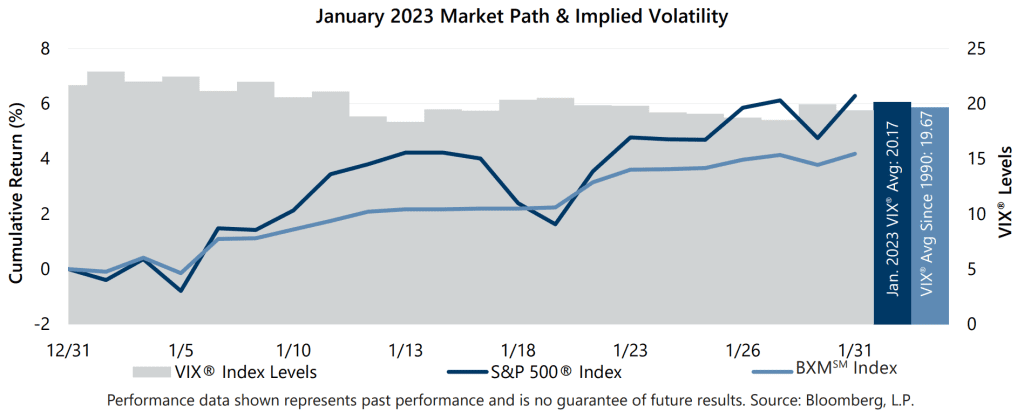The S&P 500® Index returned 6.28% in January. The advance was propelled by early and small signs of progress in the Federal Reserve’s (the Fed) effort to tame persistently high inflation paired with a less-hawkish tone from Fed officials, which renewed investor optimism that the central bank would moderate its pace of monetary tightening. Through month-end, the S&P 500® Index has climbed 14.53% from its 2022 low set on October 12, yet remains 12.63% below its most recent high set on January 3, 2022.
Data released in January showed a steady U.S. economy, stable labor market and slightly slower pace of inflation amidst ongoing tightening of monetary policy. The first estimate of Gross Domestic Product for the fourth quarter of 2022 showed that the U.S. grew by an annualized rate of 2.9%, better than the consensus expectation of 2.6%. The December unemployment rate of 3.5% was a decline from the prior month and was slightly better than the consensus estimate, while the participation rate ticked up to 62.3%. The December Consumer Price Index, released January 12, showed a year-over-year increase of 6.5%, which was in line with the consensus expectation. Fourth quarter aggregate operating earnings were on track to decline nearly 2.5% quarter-over-quarter while decreasing almost 5% year-over-year. With just over 33% of S&P 500® Index companies reporting, nearly 75% met or exceeded analyst estimates.
Implied volatility, as measured by the Cboe® Volatility Index (the VIX®), averaged 20.17 in January. Consistent with its typical relationship, average implied volatility exceeded realized volatility, as measured by the standard deviation of daily returns for the S&P 500® Index, which was 16.66% for the month. The VIX® ended December at 21.67, reached an intra-month high of 22.90 on January 3, then drifted to an intra-month low of 18.35 on January 13. The VIX® ended the month at 19.40.

The Cboe® S&P 500 BuyWriteSM Index1 (the BXMSM) returned 4.18% in January, lagging the S&P 500® Index by 210 basis points. On the third Friday of each month, the BXMSM writes a new index call option as the option it wrote the previous month expires. The premiums the BXMSM collects on its written index call options have significant influence on its return potential during market advances and help to mitigate market declines. The BXMSM began the month with an out-of-the-money written index call option due to the market decline during December, leading to relatively elevated market exposure during the first three weeks of January. The market advance plus the remaining time premium to earn from its out-of-the-money index call option combined to help the BXMSM outpace the S&P 500® Index from the beginning of the month. The BXMSM returned 2.23% through January 19, the day prior to the expiration of its written call option, while the S&P 500® Index returned 1.62% over the same period. On January 20, the BXMSM wrote a new index call option with a February expiration and collected a premium of 2.28%. Earning a portion of the premium it received contributed to the return of the BXMSM over the remainder of the month, but this was insufficient to keep pace with the rapid advance of the equity market. The BXMSM returned 1.91% from its closing value on January 19 through month-end, while the S&P 500® Index rallied an impressive 4.59% over the same period.
The Bloomberg U.S. Aggregate Bond Index returned 3.08% in January. The yield on the 10-year U.S. Treasury Note (the 10-year) ended December at 3.87%, which was also its January high. The yield on the 10-year then drifted down and reached an intra-month low of 3.37% on January 18 before climbing to end the month at 3.51%. The yield on the 2-year U.S. Treasury Note continued to exceed that of the 10-year throughout January – maintaining its inverted relationship that began on July 5, 2022.
1The BXMSM is a passive total return index designed to track the performance of a hypothetical buy-write strategy on the S&P 500® Index. The construction methodology of the index includes buying an equity portfolio replicating the holdings of the S&P 500® Index and selling a single one-month S&P 500® Index call option with a strike price approximately at-the-money each month on the Friday of the standard index-option expiration cycle and holding that position until the next expiration.
Sources: Morningstar DirectSM, Bloomberg, L.P. Performance data shown represents past performance and is no guarantee of, and not necessarily indicative of, future results.
For more information and access to additional insights from Gateway Investment Advisers, LLC, please visit www.gia.com.


